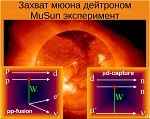|
Experiment "MuSun" (PSI, Switzerland).
 PNPI Group Leader: A.A. Vorobyov, A.A. Vasiliev
PNPI Group Leader: A.A. Vorobyov, A.A. Vasiliev
A series of experiments to study the interactions between negative muons and hydrogen isotopes have been carried out
by PNPI scientists in the frame of an international collaboration utilizing the exceptional muon source
of the Paul Scherrer Institute, Switzerland.
Muon capture on the deuteron is the simplest weak interaction process on a nucleus that can both be calculated and measured
to a high degree of precision.
This process is the main subject of the study of the MuSun experiment. And the experimental aim is to measure
the rate Λd for muon capture on the deuteron to better than 1.5% precision.
The measurement will provide a benchmark result, far more precise than any current experimental information on weak
interaction processes in the two-nucleon system. Moreover, it can impact our understanding of fundamental reactions
of astrophysical interest, like solar pp fusion and the ν + d reactions. Recent effective field theory calculations
have demonstrated that all these reactions are related to one axial two-body current term, parameterized by a single
low-energy constant. Muon capture on the deuteron is a clean and accurate way to determine this constant. Once it is known,
the above mentioned astrophysical, as well as other important two-nucleon reactions, will be determined in a model
independent way at the same precision as the measured muon capture reaction.
Experiment MuSun
- a continuation of a series of works on the study of the capture of the negative muon by light nuclei.
A common methodological feature of experiments is the concept of an "active target," which inherits the successful
experience of developing and using the ionization chamber IKAR.
Experiment "POLFUSION" on nuclear DD fusion.
 PNPI Group Leader: A.A. Vasiliev
PNPI Group Leader: A.A. Vasiliev
The growing energy consumption worldwide increases the interest in investigation of alternative energy sources.
One of the most important sources is nuclear energy, in particular, the energy of fusion. The cross sections of nuclear
reactions with participation of light nuclei are well studied; however, not all their parameters are known at present.
This is especially true for the spin sector, since the influence of spin effects on reactions with light nuclei is rather large.
A promising field of investigations is the idea of polarized nuclear fusion, i.e., the use of fuel in a certain spin state.
Such fuel, according to theoretical estimates, may possess several advantages.
The PolFusion experiment is under preparation at the National Research Center Kurchatov Institute—PNPI, in collaboration
with Forschungszentrum Juelich, Germany, and INFN/University of Ferrara, Italy; the experiment will study the 2 H(d, n) 3 He
and 2 H( d,p ) 3 H reactions with a polarized beam and target at low energies up to 100 keV. In this experiment,
the differential cross sections and spin-correlation coefficients will be measured for various beam and target polarizations.
More detailed information about PolFusion experiment can be found
PolFusion experiment.pdf,
see the presentation
"Experiment "POLFUSION" (PNPI)
and article
"DOUBLE POLARIZED d–d-FUSION EXPERIMENT"
in HEPD report
"PNPI HEPD 2013-2018" - pages 355-361).

|